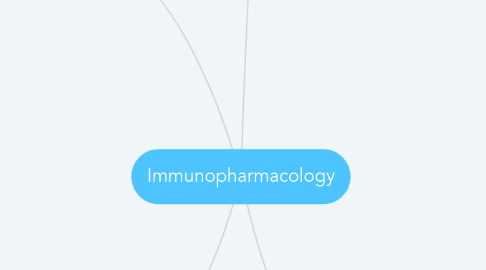
1. Immunostimulants
1.1. Cytokine inducing molecules e.g. Poly I:C- Induces interferon
1.2. IL-2 and type 1 IFN
1.3. Vaccines
1.4. Micronutrients (Vitamins A & D)
1.5. Micronutrients (Zinc)
2. Immunosuppresive drugs
2.1. False metabolites
2.1.1. Azathioprine cleaved into 6-MP
2.1.1.1. 6-MP incorrectly incorporated into DNA = cell death
2.1.1.1.1. Xanthine oxidase converts 6MP to thiobarbituric acid, detoxifying it
2.1.1.1.2. Stopped by allopurinol
2.2. Alkylating agents
2.2.1. Cyclophosphamide
2.2.1.1. Active form is aldophosphamide, oxidation results in inactive excreted form
2.2.1.2. Acts by forming irreversible cross bridges between N7 of guanosides
2.2.2. Cytochrome P450 in liver converts to 4-OH-cpa
2.3. Inhibitors of nucleotide synthesis
2.3.1. Mycophenonic acid
2.3.1.1. Inhibits de novo synthesis of guanosine by inhbiting action of IMP dehydrogenase
2.3.1.1.1. Non-competitively allosterically regulates enzyme
2.4. Side effects
2.4.1. Hair loss
2.4.2. GI damage
2.4.3. Skin damage
3. Specific immunosuppression
3.1. Anti-lymphocytic globulin
3.1.1. Derived from serum of large animals
3.1.2. Reacts to human lymphoid cells
3.1.3. Targets peripheral blood lymphocytes
3.1.3.1. Long term target is thymus dependant lymphocytes
3.1.4. Binds to T cell surface and lyses by complement
3.1.4.1. Results in impairment of DTH and cellular immunity, no effect on Ab response
3.1.5. Side effects
3.1.5.1. Foreign protein inoculation
3.1.5.2. Precipitation of immune complex
3.2. Macrolides- Fungus derived
3.2.1. Agonistic molecules include rapamycin, FK506 and cyclosporin A
3.2.1.1. Cyclosporin A significantly increases 1 year kidney survival post transplant
3.2.1.1.1. Suppresses alloantigen specific T cells, proliferation, cytotoxic T cell numbers & IL-2/IFN-G levels
3.2.1.1.2. Can cause nephrotoxicity
3.2.1.2. FK506 acts similarly to CsA except has 100% success rate with liver transplant and low cytotoxicity
3.2.1.3. Rapamycin effective after T cell activation and with highyl histocompatible organs
3.2.1.3.1. Greater potency and survival than FK506
3.2.1.3.2. Causes GI ulceration, vasculitis & testicular atrophy
3.2.2. Antagonists include 506BD
3.2.3. Macrolide binding proteins
3.2.3.1. CsA binds to cyclophilin in cytosol
3.2.3.2. FK506 and rapamycin bind to FKBP
3.2.3.2.1. These proteins are rotamases
3.2.3.3. CsA and FK506 inhibit calcineurin
3.2.3.3.1. Prevents it from converting NFATc to NFATn and triggering IL-2 expression
3.2.3.4. Rapamycin and FKBP form complex that inhibits mTOR
3.2.3.4.1. Inhibits signalling pathway triggered by IL-2
4. Steroids
4.1. Glucocorticoids
4.1.1. Basic molecule for anti-inflammatory steroids
4.1.2. Body's endogenous glucocorticoid is cortisol
4.1.3. Inhibitory effect
4.1.3.1. Can inhibit before or after cytokines are produced
4.1.3.2. Directly binds receptors and translocate to the nucleus to prevent transcription
4.1.3.3. Induces lipocortin prodcution to inhibit prostaglandin production
4.1.3.4. Has no effect on cyclooxygenase

